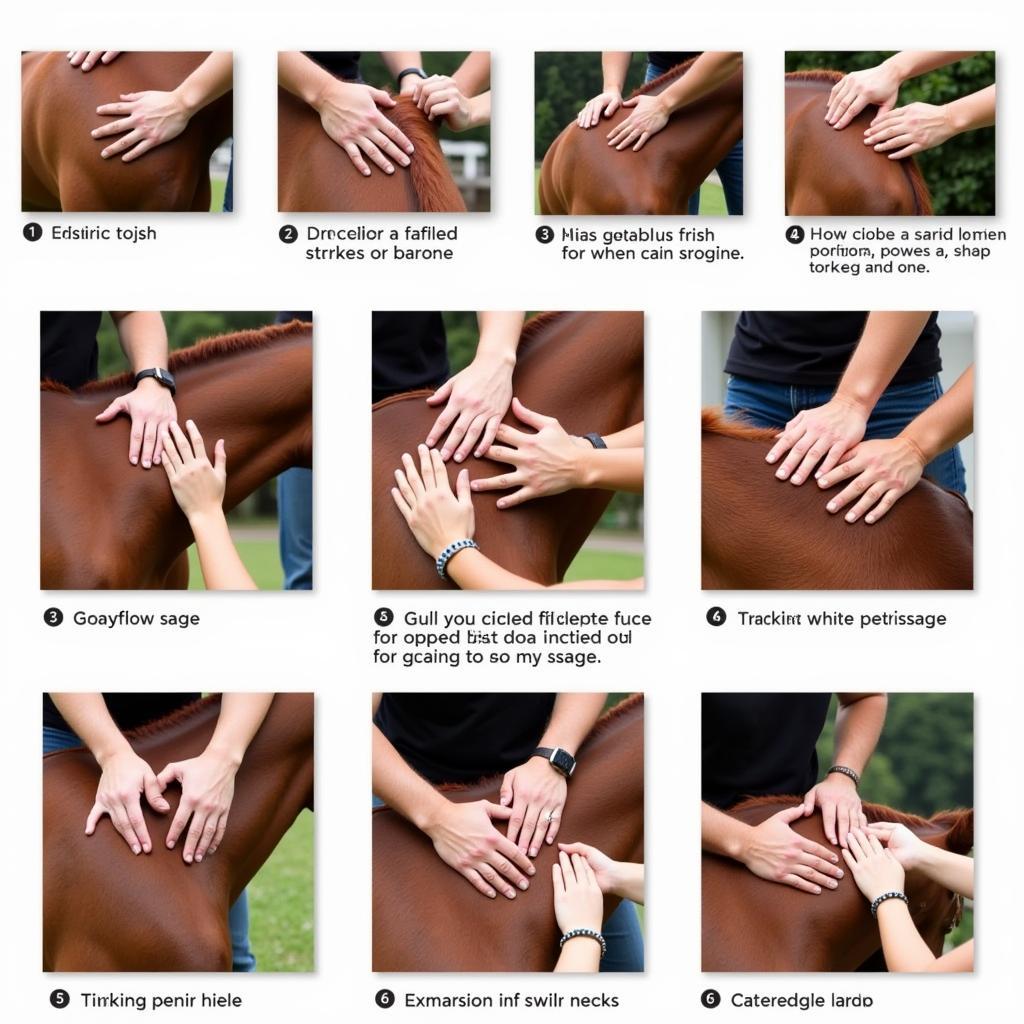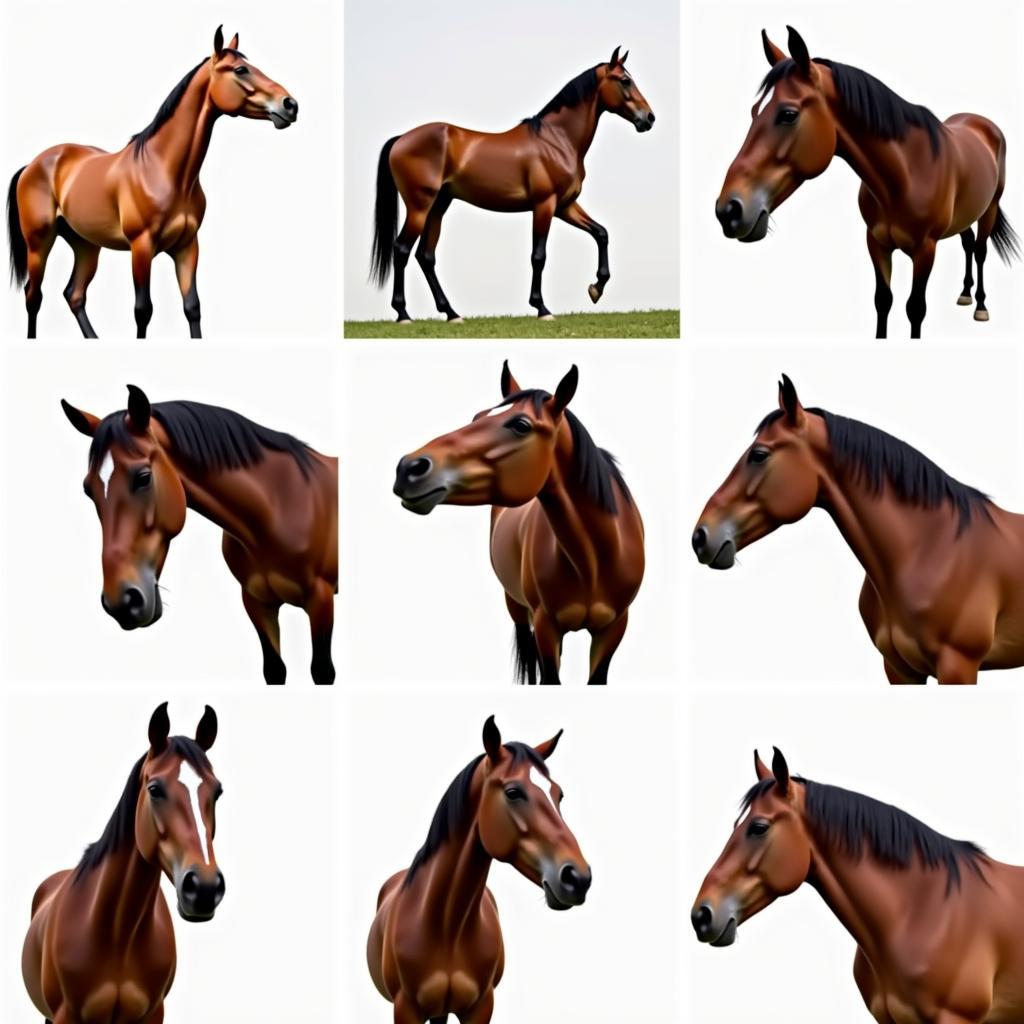The Horse Muscles Neck is a complex and fascinating structure, vital for balance, movement, and communication. Understanding its intricacies can significantly enhance your horsemanship and improve your horse’s well-being. This article delves into the anatomy, function, and care of the equine neck, offering valuable insights for every horse owner and enthusiast. After reading the article about horse anatomy neck, you’ll be equipped to better understand and care for your horse.
The Anatomy of a Horse’s Neck
The horse’s neck is comprised of a sophisticated network of muscles, ligaments, and tendons, all working in harmony to support the head and facilitate a wide range of movements. These muscles are categorized into several groups based on their location and function, including extensors, flexors, and lateral flexors. The nuchal ligament, a strong, elastic band, runs along the top of the neck, providing crucial support for the head and neck.
The brachiocephalicus muscle, a prominent muscle in the lower neck, plays a significant role in extending the shoulder and moving the leg forward. The splenius and semispinalis capitis muscles, located in the upper neck, are essential for raising and lowering the head. The complex interplay of these muscles allows for the intricate movements we observe in horses, from grazing to jumping.
The Function of Horse Muscles Neck
The horse muscles neck serves several critical functions, far beyond simply holding up the head. They are instrumental in maintaining balance, enabling movement, and facilitating communication. For instance, the horse uses its neck muscles to shift its center of gravity, crucial for maintaining equilibrium while turning, jumping, and carrying a rider.
The neck muscles also play a vital role in locomotion. By extending and flexing the neck, the horse can adjust its stride length and speed. The neck acts as a counterbalance, allowing the horse to make quick turns and changes in direction. Moreover, the horse uses its neck to communicate its mood and intentions. A lowered neck might indicate submission or relaxation, while a raised neck can signify alertness or dominance.
Caring for Your Horse’s Neck Muscles
Proper care of your horse’s neck is paramount for maintaining its health and performance. Regular exercise, appropriate tack, and proper riding techniques are crucial for preventing muscle soreness and injury. Incorporating exercises that encourage stretching and strengthening, such as carrot stretches and long and low work, can help maintain muscle flexibility and prevent stiffness.
Ensuring your horse’s saddle fits correctly is also vital, as an ill-fitting saddle can cause pressure points and muscle strain. You can learn how to correctly measure a horse for a saddle to ensure the perfect fit. Additionally, correct riding techniques, such as maintaining a balanced seat and avoiding pulling on the reins, can help prevent unnecessary stress on the neck muscles. The position of the horse’s head and neck, known as bascule horse, also plays a significant role in its athletic performance.
 Effective Horse Neck Massage Techniques
Effective Horse Neck Massage Techniques
Remember the importance of vaccinating your horse against diseases like botulism, which can affect muscle function. Learn more about botulism in horses vaccine. Regular veterinary checkups are also essential to identify and address any potential issues early on.
Common Questions about Horse Muscles Neck
Why is my horse’s neck stiff? Stiffness can be caused by various factors, including muscle strain, arthritis, or an ill-fitting saddle.
How can I improve my horse’s neck muscles? Regular exercise, proper stretching, and correct riding techniques can help strengthen and improve flexibility.
What are the signs of a neck injury in a horse? Signs can include swelling, heat, pain, stiffness, and reluctance to move the neck. You can read more about the horse trapezius muscle to further your understanding of this specific muscle group.
 Beneficial Horse Neck Stretches
Beneficial Horse Neck Stretches
Conclusion
The horse muscles neck is a marvel of biological engineering, playing a crucial role in the horse’s balance, movement, and communication. By understanding its intricate anatomy and function, we can better appreciate the athleticism and grace of these magnificent animals. Proper care and attention to the horse’s neck muscles are essential for maintaining its health, well-being, and optimal performance. Remember, a healthy neck is a happy neck!
FAQ
- What is the nuchal ligament’s function? It supports the head and neck.
- How can I tell if my horse’s saddle fits correctly? Consult a saddle fitter.
- What are some common neck injuries in horses? Strains and sprains.
- Why is proper riding technique important for neck health? It prevents strain.
- What should I do if I suspect my horse has a neck injury? Consult a vet.
- How can I help my horse build stronger neck muscles? Targeted exercises and stretches.
- What role does the neck play in a horse’s balance? It acts as a counterbalance.
If you have any questions or need further assistance, please contact us: Phone: 0772127271, Email: [email protected] or visit us at QGM2+WX2, Vị Trung, Vị Thuỷ, Hậu Giang, Việt Nam. Our customer service team is available 24/7.